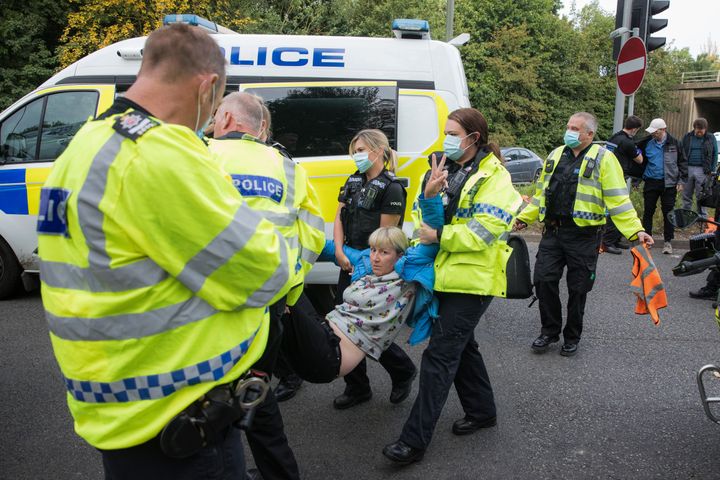
Climate protesters blocked four major junctions on the M25 on Monday morning, causing significant delays and leading to dozens of arrests.
Insulate Britain is a campaign group which wants the government to fully fund the insulation of all British social housing, and produce a legally-binding plan for a low-carbon whole-house retrofit of all homes in the UK by 2030.
Protesters in fluorescent jackets blocked slip roads and arranged themselves across the motorway, enraging drivers during Monday’s rush hour.
At least 78 demonstrators were then arrested after targeting motorists at Junction 6, Junction 20, Junction 3, Junction 31 and Junction 15 at Heathrow.
Essex Police arrested 12 people, while Hertfordshire Police arrested a further 18 and Surrey Police arrested a further 36 on suspicion of public nuisance and wilful obstruction.
Kent Police arrested 12 people.
How did people react?
Thousands of drivers were then stuck in standstill traffic as a result, leading some furious run-ins between the protesters and those keen to carry on with their journey.
One driver told the activists: “A lot of people might have backed your cause, but it’s ruined by you doing this sort of thing.”
Another told LBC that his journey, which was now three times as long due to the protest, actually “wasted so much diesel and caused so much pollution”.
But an Insulate Britain supporter told the radio station: “What this is about is getting homes insulated so that we don’t have fuel poverty in this country, so that people can not worry about heating their houses.”
Another supporter said: “We’re driven to this... I wish we didn’t have to do this.
“The government aren’t sticking to their own targets. They’ve made 12% progress towards their target in use of power and energy in this country.”
Former chief constable Sir Hugh Orde told LBC that the demonstration was incredibly dangerous.
He said: “It’s worth reminding ourselves these people tried to stop a live motorway running, that is extraordinarily dangerous.
“It puts their lives at risk, it puts motorists’ lives at risks and it puts police officers’ lives at risk.”
Chief Inspector Paul Austin released a statement, which read: “This incident caused significant disruption and our officers worked to resolve it as quickly and safely as possible.
“I want to thank the drivers affected for their patience and understanding.”
Does civil disobedience even work?
This is a tactic seen across history and particularly used in the UK in recent years, in an effort to bring about significant change.
Extinction Rebellion have just ended two weeks of civil disobedience predominantly in London, but they targeted many institutions they associated with the climate crisis rather than ordinary people.
The XR activists have also pointed out in the past that plights such as the fight for women’s suffrage, the salt march in India 1930, and poll tax refusal are just a handful of examples were non-violent demonstrations have worked.
Climate campaigners Greenpeace, defended the method on their website, writing: “As a tactic, logic itself is limited. The truth needs public outcry.”
However, this particular incident has been torn online for affecting regular citizens rather than the industries responsible for the problem.
Many people have claimed the demonstration may only have contributed towards carbon dioxide emissions by forcing thousands of cars to idle their engines.
Insulate Britain defended itself on Twitter, writing: ”Why are we causing disruption to ordinary people? We must get the government’s attention.
“Mass disruption gets the attention of the government and media, not another lobby outside parliament.
“Our actions are a legal and proportional response to our government’s inactivity.”
The incident did trend at number 3 out of the top 10 topics trending in the UK on Twitter, and several accounts said this was the first time they had heard of the pressure group.
LBC’s presenter James O’Brien also pointed out that it was a peaceful protest and had a clear goal.
The government has yet to comment on the protest.
